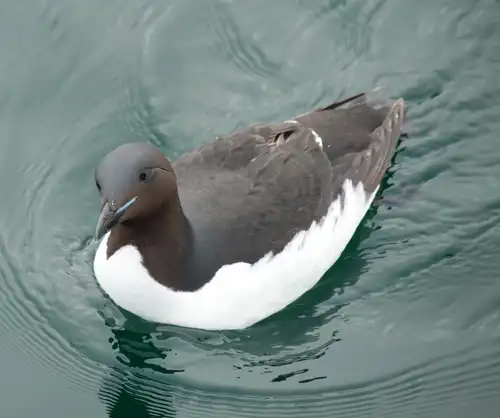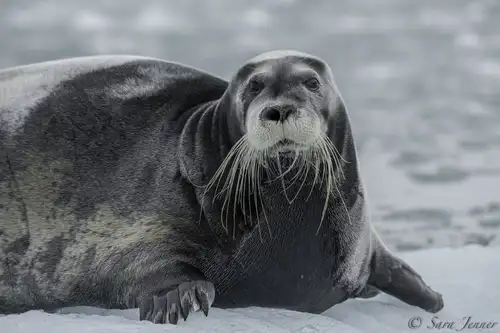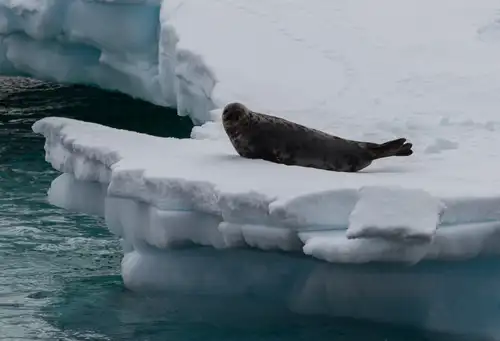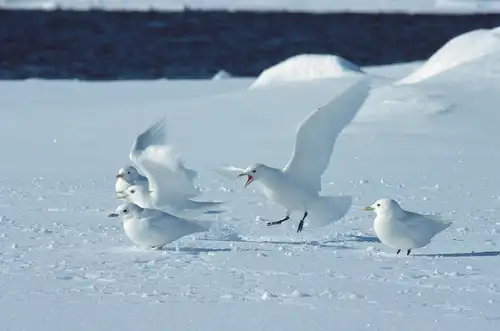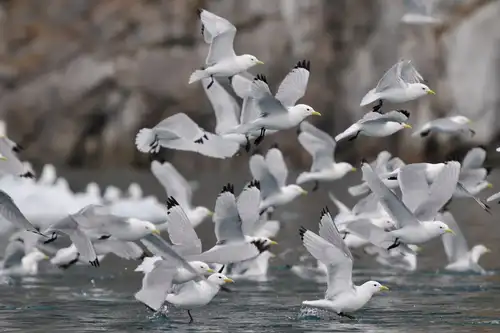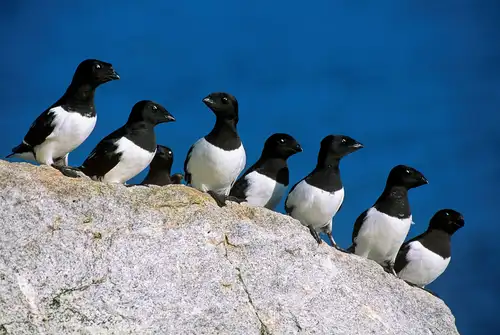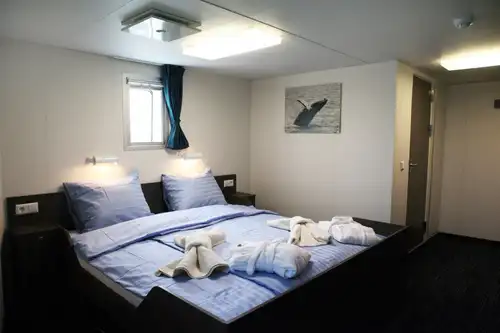


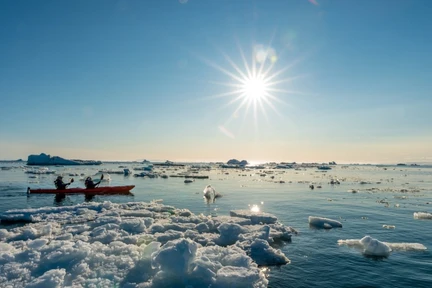













































 8 Days/7 Nights
8 Days/7 Nights




Our Basecamp cruises focus on land and near-shore activities with minimal disturbance to local wildlife. If time and conditions allow, the expedition team will also seek wildlife opportunities.
A basecamp is a temporary camp for expeditions or outdoor activities. During our Basecamp cruises, the ship stays in selected areas around North Spitsbergen, serving as a hub for various outdoor activities.
- Hikers can enjoy vigorous walks in the backcountry.
- Photographers can capture the dramatic surroundings.
- Kayakers can explore waterways inaccessible to the ship.
- Others can enjoy Zodiac excursions and easy shoreline walks focused on wildlife.
All activities are free of charge.
Summer Solstice:
Experience the midnight sun during the Arctic summer, when the sun is visible for 24 hours. The summer solstice in Longyearbyen is on June 21, with the sun at its highest at midnight. Join us to witness this phenomenon in the Arctic wilderness of Svalbard.
Arrival in Longyearbyen
Arrive in Longyearbyen, the main town of Spitsbergen. Explore this former mining town with its church and museum. In the evening, the ship sails out of Isfjorden, where you might see a minke whale.
Kongsfjorden and Blomstrand Peninsula
Start the activity program at Blomstrand Peninsula, sheltered by the fjord. Visit Ny Alesund, a research center with a history of Arctic exploration. In the evening, head north along the west coast to Krossfjorden.
Exploring the North West
Visit Amsterdam Island to hike past a 17th-century whaling station and enjoy the panorama of Smeerenburgsleta. In the afternoon, explore the islands around Fair Haven.
Rugged Raudfjorden
At Raudfjorden, see glaciers and possibly seals. The area supports seabird colonies and vegetation, with a chance to spot polar bears. Balance activities with wildlife watching.
Liefdefjorden Sights
Weather permitting, sail into Liefdefjorden to see Monaco Glacier. The area is a feeding spot for kittiwakes and a polar bear hunting ground. If ice prevents sailing, use an alternate route along the west coast of Spitsbergen.
North Spitsbergen Adventures
Reserve day for activities around North Spitsbergen. Choose the best location for outdoor adventures based on weather and wildlife.
Forlandsundet or St. Johns Fjord
Explore Forlandsundet, known for its beauty and wildlife, including walruses and seabirds. Alternatively, sail into St. Johns Fjord or Isfjorden, landing at Alkhornet. Arrive in Longyearbyen later that night.
Return to Longyearbyen
Disembark in Longyearbyen, taking home memories of your adventure.

Scuba Diving Trips in Antarctica and the Arctic
Our polar voyages provide maximum firsthand contact with local wildlife and terrain, as well as unparalleled adventures below the waves.
Hiking the Surreal Terrain of the Arctic and Antarctica
There's no better way to explore a new area than on foot. We offer a variety of hiking expeditions for all levels, from casual walkers to hard-core enthusiasts.
Explore the Arctic and Antarctic Coastline in a Kayak
Even after exploring shores, mountains, and spotting wildlife, there’s a whole world to discover on the water. Polar kayaking offers a unique way to experience the blue-and-white beauty of the polar seas, visiting stunning ice formations and waterways too small for our ships.
Join Our Expert-Led Photography Workshops
Visiting the polar regions is an indescribable experience. Our photography workshops help you capture incredible photos to complement your descriptions. On select voyages, professional photographers assist you in getting the best shots with your camera equipment through our free photo workshop activity.
The Amazing Activities of the Basecamp Voyage
A polar expedition cruise offers an array of exotic wildlife, dramatic landscapes, and invigorating outdoor activities. Our signature Basecamp voyages take this experience to another level.







































































m/v Ortelius
The ice-strengthened Ortelius is fully equipped for polar exploration and can accommodate helicopter flights when necessary.

Specifications
| Passengers: | 108 passengers in 50 cabins |
| Staff & crew: | Crew 44 | Guides 8 | Doctor 1 |
| Length: | 90.95 meters |
| Breadth: | 17.20 meters |
| Draft: | 5.4 meters |
| Ice class: | UL1 (Equivalent to 1A) |
| Displacement: | 4090 tonnes |
| Propulsion: | 6 ZL 40/48 SULZER |
| Speed: | 10.5 knots average cruising speed |
Cabins Gallery


Ship Interior Gallery


Ship Exterior Gallery


Ortelius was originally the Marina Svetaeva. Built in Gdynia, Poland in 1989, it served as a special-purpose vessel for the Russian Academy of Science. Later it was re-flagged and renamed after the Dutch/Flemish cartographer Abraham Ortelius (1527 – 1598), who in 1570 published the first modern world atlas: Theatrum Orbis Terrarum or Theater of the World. At that time his atlas was the most expensive book ever printed. Ortelius is classed by Lloyd’s Register in London and flies the Dutch flag.
Perfect for Any Expedition
The vessel has the highest ice-class notation (UL1, equivalent to 1A) and is therefore suitable to navigate in solid one-year sea ice as well as loose multi-year pack ice. Ortelius can accommodate up to 108 passengers and has an abundance of open-deck spaces. It is manned by 24 highly experienced nautical crew members, 20 hotel staff, eight expedition specialists (one expedition leader, one assistant, and six lecturer-guides), and one doctor.
Ortelius: a Vessel with Comfort and Character
Please be aware that a small number of cabins may have a partially obstructed view due to the size of the windows and the design requirements of the ship. For example, some windows may be partly obstructed in the lower half by a gangway. The best view is always on the outer deck or the bridge. Though our voyages are primarily meant to offer our passengers an exploratory wildlife program with as much time ashore as possible, Ortelius offers all the comforts of a standard hotel ― along with a bar and lecture room. Flexibility assures maximum wildlife opportunities. As such, Ortelius carries 10 Zodiacs with 60hp Yamaha engines.
What to Wear
In keeping with the spirit of expedition, dress on board is informal. Bring casual and comfortable clothing for all activities, and keep in mind that much of the scenery can be appreciated from deck ― which can be slippery. Bring sturdy shoes with no-slip soles, and make sure your parka is never far away in case one of our crew shouts “Whales!” over the loudspeaker and you have to dash outside in a moment’s notice. Opt for layers, as it is comfortably warm aboard the ship though often cold on deck.
How to Pay
Refreshments and souvenirs will be charged to your cabin. The day before departure you can settle your bill with the hotel manager, paying by credit card (Visa or MasterCard) or cash (euro, or in some cases dollar). We cannot, however, accept checks. Though the prices and standard currency on board is in the euro, other currencies may be accepted at the discretion of the hotel manager, at prevailing rates.
Electric Current
The electrical supply aboard ship is 220v, 60Hz. Electrical outlets are standard European with two thick round pins, so some passengers may need a 220v/110v converter.
Gratuities
The customary gratuity to the ship’s service personnel is made as a blanket contribution at the end of the voyage and is divided among the crew. Tipping is a personal matter, and the amount you wish to give is at your sole discretion. As a generally accepted guideline, we suggest 8 ― 15 euros per passenger per day. It is better for the crew if you give cash.
Non-Smoking Policy
We have a non-smoking policy inside all our vessels, though you can smoke in certain designated areas. We ask that you please respect the wishes of non-smokers.
Your Physical Condition
You must be in good overall health and be able to walk several hours per day. The expedition is ship-based and physically not very demanding, but we spend as much time as possible on shore. You are, however, welcome to remain aboard the ship if you prefer. To join most excursions you must be able to get up and down the steep gangway ― from the ship to the water level ― to board the Zodiacs. Staff will assist you in and out of the boats, and boarding will become progressively easier with practice, but conditions on shore can be slippery and rocky. Remember, you will be traveling in remote areas without access to sophisticated medical facilities, so you must not join this expedition if you have a life-threatening condition or need daily medical treatment.
- Weather is always an unknown factor and can change quickly and often. Temperatures can be cold, though not perhaps as cold as you might expect. On calm sunny days, it can feel quite warm. But wet, windy weather must also be expected. Wind chill factor is always a consideration.
- We use sturdy inflatable Zodiac boats for all landings. As there are few harbors in the areas we sail, these boats are critical to our expeditions. Our motor vessels are equipped with gangways for boarding the Zodiacs, but our sailing vessel uses a small side ladder. Using this ladder is not very demanding, but passengers must be physically able to climb and descend them.
- No, you are not able to change currency on board.
- The currency used on all vessels is the Euro, but you can also pay with USD.
- As polar bears can travel great distances in a day, it is impossible to say where and when we will spot them. Sea ice is the best place to look, so we tend to focus our efforts there. Though you will have a good chance of seeing polar bears in Svalbard, nature makes the decisions. Sightings cannot be guaranteed.
- Spitsbergen uses CET/Greenwich Mean Time +1 (GMT +1). This means that if it is 22:00 GMT (10 p.m.) during your cruise to Spitsbergen, it would be 16:00 (4 p.m.) in New York City, USA, 21:00 (9 p.m.) in London, U.K. and 09:00 (9 a.m.) the next morning in the Antarctic South Pole.
- The number of passengers is limited to approximately 116 on the Ortelius. Furthermore the vessel is manned by 20 highly experienced international nautical crew, 19 international hotel crew, including stewardesses, 7 expedition staff in Antarctica (1 expedition leader and 6 guides/lecturers) and 1 doctor.
- The Ortelius was built in Poland in 1989 for the Russian Academy of Science.
You May Also Like



Alpine Peaks of Spitsbergen, Ski & Sail
 8 Days / 7 Nights
8 Days / 7 Nights

Arctic Ocean - Fair Isle, Jan Mayen, Ice Edge, Spitsbergen, Birding
 10 Days / 9 Nights
10 Days / 9 Nights
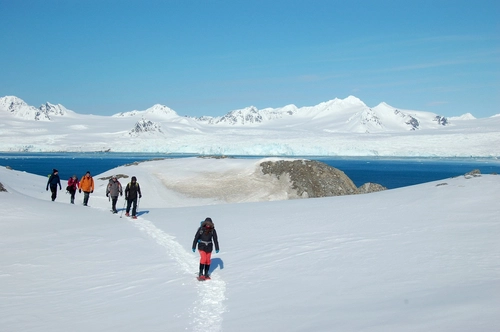
North Spitsbergen - Arctic Spring , Hike & Sail
 8 Days / 7 Nights
8 Days / 7 Nights

North Spitsbergen Explorer - Into the pack ice - Polar Bear Special
 8 Days / 7 Nights
8 Days / 7 Nights

Arctic Ocean - Jan Mayen, Ice edge, Spitsbergen, Birding
 9 Days / 8 Nights
9 Days / 8 Nights

Arctic Ocean - Fair Isle, Jan Mayen, Ice edge, Spitsbergen, Birding - Summer Solstice
 10 Days / 9 Nights
10 Days / 9 Nights

North Spitsbergen Explorer - Versatile landscapes, sea ice & wildlife
 8 Days / 7 Nights
8 Days / 7 Nights

North Spitsbergen Basecamp – Summer Solstice - Free Kayaking, Hiking, Photo Workshop, Diving (supplemented)
 8 Days / 7 Nights
8 Days / 7 Nights

North Spitsbergen Explorer - Versatile landscapes, sea ice & wildlife - Summer Solstice
 8 Days / 7 Nights
8 Days / 7 Nights

North Spitsbergen - Arctic Summer
 11 Days / 10 Nights
11 Days / 10 Nights

East Spitsbergen - Home of the Polar Bear, Including Long Hikes & Cleaning the Shores
 8 Days / 7 Nights
8 Days / 7 Nights

Around Spitsbergen, In the realm of Polar Bear & Ice
 10 Days / 9 Nights
10 Days / 9 Nights

North Spitsbergen Explorer – Into the Pack Ice – Polar Bear & Whale Special
 10 Days / 9 Nights
10 Days / 9 Nights

Northeast Greenland Solar Eclipse Explorer Voyage
 14 Days / 13 Nights
14 Days / 13 Nights

Spitsbergen - Northeast Greenland, Fly & Sail
 20 Days / 19 Nights
20 Days / 19 Nights

Around Spitsbergen incl. Nordaustlandet
 10 Days / 9 Nights
10 Days / 9 Nights

Alpine Peaks of Spitsbergen - Ski & Sail
 8 Days / 7 Nights
8 Days / 7 Nights

Arctic Ocean - Fair Isle, Jan Mayen, Ice Edge, Spitsbergen, Birding Special
 10 Days / 9 Nights
10 Days / 9 Nights

North Spitsbergen Explorer - Versatile Landscapes, Sea Ice & Wildlife
 8 Days / 7 Nights
8 Days / 7 Nights

North Spitsbergen Explorer - Into the Pack Ice - Polar Bear Special
 8 Days / 7 Nights
8 Days / 7 Nights

North Spitsbergen, Arctic Summer - Summer Solstice
 11 Days / 10 Nights
11 Days / 10 Nights

North Spitsbergen Explorer - Versatile Landscapes, Sea Ice & Wildlife - Summer Solstice
 8 Days / 7 Nights
8 Days / 7 Nights

North Spitsbergen Explorer - Into the Pack Ice - Polar Bear Special - Summer Solstice
 8 Days / 7 Nights
8 Days / 7 Nights

Arctic Ocean - Spitsbergen: Jan Mayen, Ice Edge & Birding - Summer Solstice
 9 Days / 8 Nights
9 Days / 8 Nights

North Spitsbergen Basecamp - Free kayaking, Hiking, Photo Workshop
 8 Days / 7 Nights
8 Days / 7 Nights

North Spitsbergen, Arctic Summer
 11 Days / 10 Nights
11 Days / 10 Nights

Around Spitsbergen, in the Icy Realm of the Polar Bear
 10 Days / 9 Nights
10 Days / 9 Nights

A Taste of North Spitsbergen - Compact Arctic Adventure
 6 Days / 5 Nights
6 Days / 5 Nights

South Spitsbergen Explorer - Bear Island - Diving (supplemented)
 10 Days / 9 Nights
10 Days / 9 Nights

Around Spitsbergen - Arctic Summer
 15 Days / 14 Nights
15 Days / 14 Nights

Around Spitsbergen and Nordaustlandet, In the Icy Realm of the Polar Bear
 10 Days / 9 Nights
10 Days / 9 Nights

Spitsbergen, Northeast Greenland & Scoresby Sund, Including Long Hikes
 14 Days / 13 Nights
14 Days / 13 Nights

South Spitsbergen, Bear Island & Mainland Norway - Aurora Borealis
 6 Days / 5 Nights
6 Days / 5 Nights

Amphibian, reptiles and herbivore mammals in the Arctic

Polar bear encounter in Spitsbergen
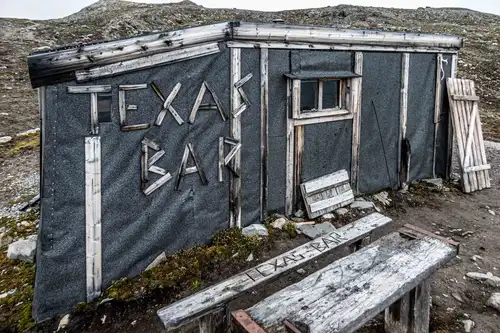
Svalbard’s Texas Bar

Birds of the North: 29 Arctic Birds and Seabirds

Around Spitsbergen vs. North Spitsbergen

Six Must-See Svalbard Sites

Polar Bear Sets Impressive New Diving Record

Seizing the Season: Spitsbergen’s Late Spring, Early Summer

15 Toothy Facts About the Atlantic Walrus

The polar bear: king of the Arctic food chain

Circumnavigating Spitsbergen
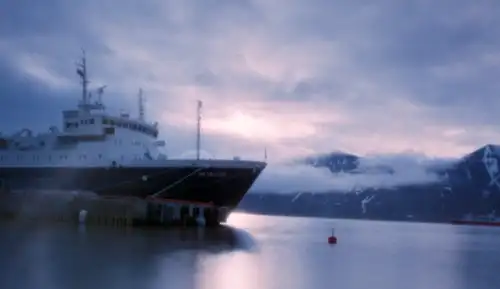
Solargraphy & Pin Hole photography in the Arctic

Polar bear feast

Arctic Icon: 10 Facts about the Polar Bear

Arctic on Foot: Hiking and Snowshoeing the Far North

Eight Engaging Reindeer Facts

The Enchanting Islands of Svalbard
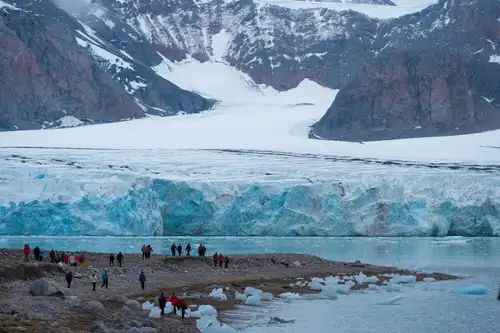
16 Conversation-Starting Svalbard Facts

Arctic Foxes: Constant Gardeners of the Arctic






























































